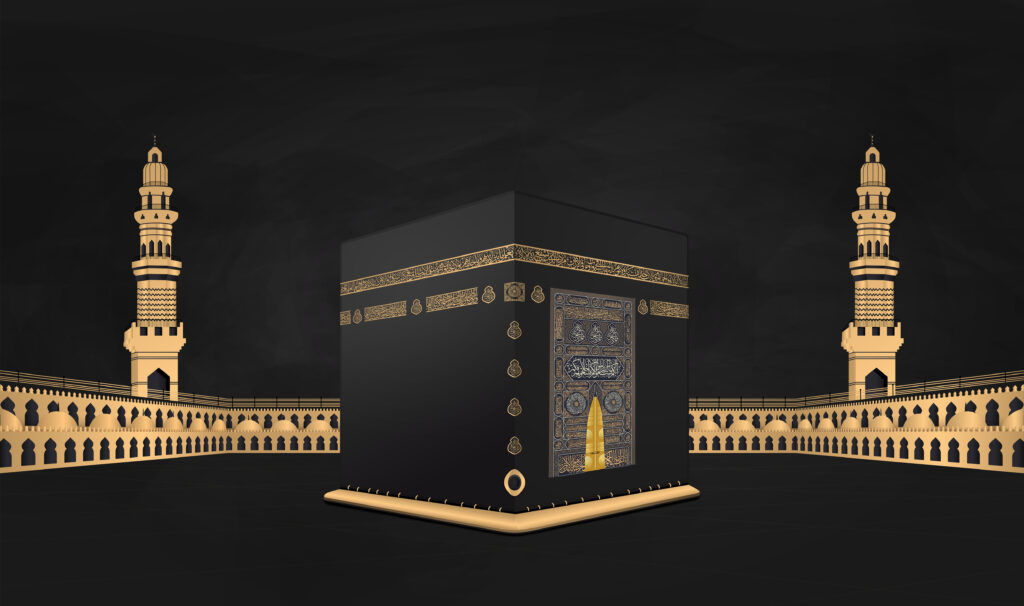
3 MARRIAGE WITH KHADIJAH
Muhammed (r) married Khadijah (t) when he was twenty-five years of age.
Khadijah, daughter of Khuwaylid, was noble and intelligent, wealthy and was respected for the quality and integrity of her heart. A widow whose age was then forty years, her late husband was Abu Hala.
She carried out on their business and like other merchants of Makkah she also used to hire men to transport her merchandise outside the country on a profit-sharing scheme.
Khadijah was impressed with Muhammed’s truthfulness, trustworthiness
and honorable character when he traded her merchandise to Syria.
Although Khadijah had turned down several offers for her hand by some of the eminent
chiefs of the Quraysh, she expressed her desire to marry Muhammed (r).
Hamza, an uncle of Muhammed (r), conveyed the message to him for which he readily agreed.
Abu Talib recited the wedding sermon and Muhammed (r), united in wedlock with Khadijah, commenced his marital career. All the offspring of the Prophet (r) except Ibrahim who died in infancy, were born to Khadijah.
RECONSTRUCTION OF THE KA’BA

In his thirty-fifth year, Muhammed (r) made a difficult decision about a matter that provoked the Quraysh and threatened to plunge them into another sacrilegious war.
The Quraysh wished to rebuild the Ka’bah and furnish it with roofs, for it was made of loose stones, and its walls were only a little higher than a man’s height.
So, the walls were demolished and the work of reconstruction was taken up, but when it was time to rebuild the Ka’bah as far as the position of the Black Stone was concerned, the question arose as to who should place the sacred relic into its place.
Every tribe claimed the honor; an imminent collision was bound to happen.
The grounds that led to wars of attrition during the early days of paganism in Arabia were nothing but inferior or insignificant when compared to the grave issue that was made as the focal point of honor on this occasion.
Banu ‘Abdul Dar brought a bowl full of blood; then they and Banu ‘Adiy pledged themselves to fight unto death by thrusting their hands into the blood.
The conflict appeared to be the starting point of a furious struggle which might have swallowed up the whole of Arabia in another of their oft-recurring wars.
The dilemma continued for a few days until it was agreed that whosoever is the first man to enter the gate of the Kabah would be made as the umpire of the matter under dispute.
And so the first man to enter came, but he was no other than the future Prophet of God (r).
“This is Muhammed”,
they said as soon as they saw him coming, and further added:
“He is trustworthy and we will abide by his decision.”
Muhammed (r) asked them to bring a cloth, took the Black Stone and put it inside the fabric, then afterwards asked each tribe to take hold of an end of the material and then simultaneously raise it to the required height.
When the people lifted the stone in such manner, Muhammed (r) placed it in its position with his own hands, and the building went on above it.
The wisdom displayed by the Prophet (r) on this occasion
, one which saved the Quraysh from measuring the might of their swords with that of the others, strikingly illustrates his sound judgment apart from divulging sparks of his genius.
The incident foreshadowed the signs of Muhammed’s prudence, profoundness of his teachings, his thoughtfulness, cool temper and the spirit of his friendliness and altruism; in fact the cardinal virtues of one who was to become the ‘Mercy for the Worlds”.
These were the qualities through which the Prophet (r) transformed a people, unruly and ferocious, continuously at war amongst each other, into a closely-knit fraternity by proving and submitting himself as a Merciful Prophet (r) before them.
HILFUL-FUDUL
It was during this period that the Quraysh came to agree upon one of the noblest covenants made in which Muhammed (r) played a prominent part.
It so happened that a man from Zabid (A town in Yemen) came to sell his merchandise in Makkah.
One of the Quraysh chieftains in the person of Al-As Ibn Wayel purchased the whole of it but paid nothing in return. Because of this, Zabid approached several influential Quraysh leaders but none of them agreed to confront Al-As Ibn Wayel.
Having been turned down by those that he had previously asked for help, Zabid called upon the people of Makkah exhorting every bold and fair-minded young man to come to his rescue.
At last, many of them, moved by embarrassment, assembled in the house of ‘Abdullah Ibn Jad’an who entertained everyone that came to his house.
Thereafter, they formed a pact, in the name of Allah, for repression of acts of lawlessness and restoration of justice to the weak and the oppressed within the walls of Makkah.
The covenant was called Hilful-Fudul wherein all its members finally approached Al-As Ibn Wayel and forced him to return the merchandise of Zabid.
Muhammed (r) had been one of the prominent movers of the pact and he always made it a point to express his satisfaction over the execution of this agreement. Once he remarked:
“I had a hand in making such an arrangement in the house of ‘Abdullah Ibn Jad’an to which
if I were invited again to help even after the advent of Islam, I would have undoubtedly
participated once more”
. Through such Hilful Fudul, they had agreed to restore upon everyone what is due of him and to protect the weak from the exploits and manipulations of the oppressors.”
for prophets stories visithttps://sunofislam.com/prophetsofgod/
for scientific miracles articles visit www.sunofislam.com
